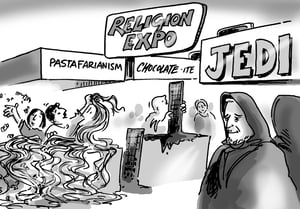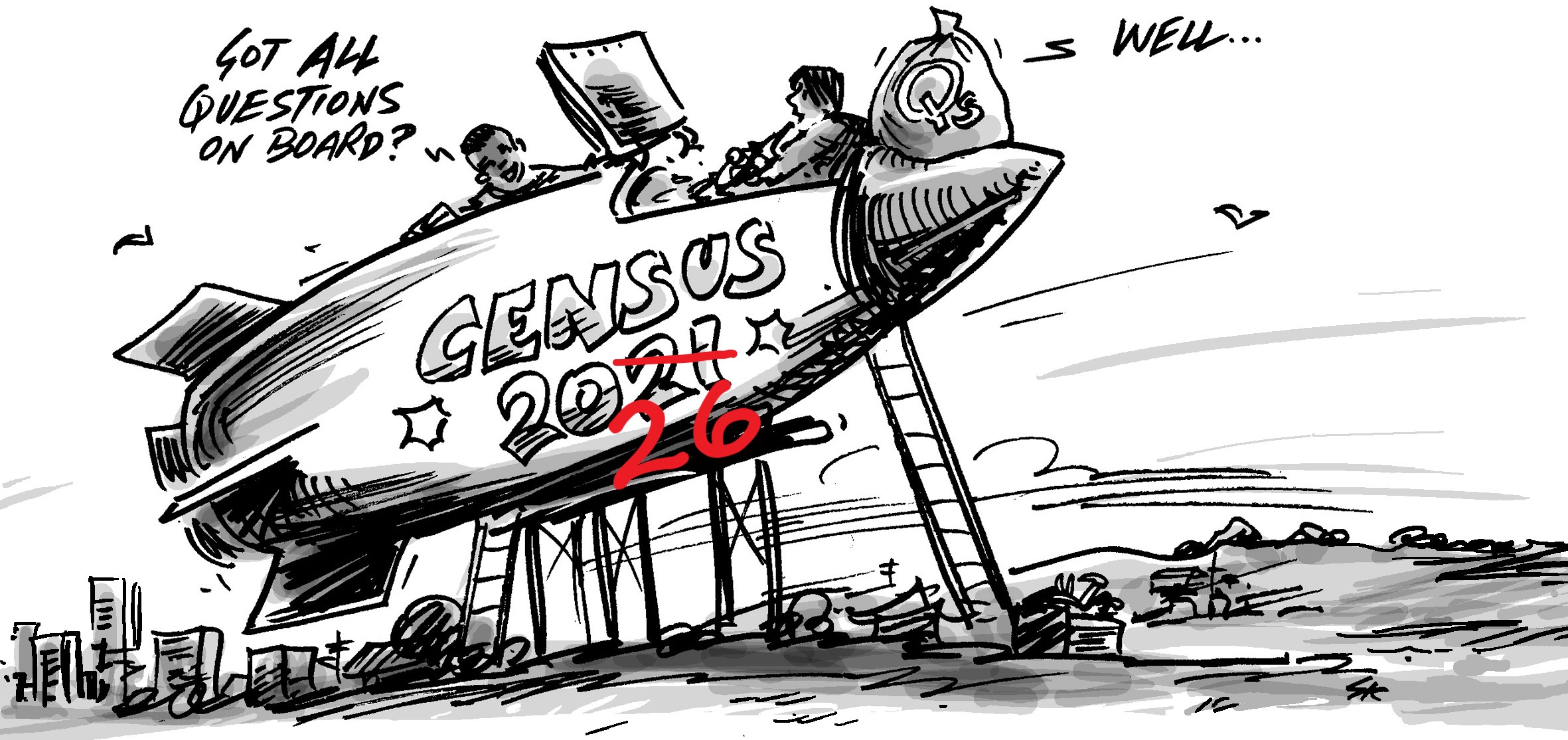The old adage, not to discuss sex, politics or religion at a dinner party can be sound advice for avoiding arguments. While nothing about politics is collected in the Census, and sex is limited to “male” and “female”, religion is the question which seems to generate the most arguments around the time of the Census collection and data release. Discussions of faith and non-faith, Christian and Muslim, Protestant and Catholic, and Jedi Knights pop up every Census. Everyone seems to have an agenda, and an interest in the religion numbers.

Despite many people calling for the religion question to be dropped or radically changed, Question 19 on the household form is the one that generates the most attention in the community, and it’s been on every Census since 1911. In this article we’ll look at some of the broad changes, particularly the growth in ‘No religion’, and also the Jedi.
Changes at the broad level – Christianity down
Historically, the largest responses to the religion question have been in the Christian denominations, reflecting Australia’s historical origins in Europe. Looking at the religion data at the broadest level for 2011 shows that this is changing . In 2011, 61.1% of the population stated a Christian religion, down from 63.9% in 2006, and 74.0% back in 1991. This figure has shown a steady decline over a period of decades. In part this is due to growth in other religious groups with the change in the source countries of migrants to Australia, and in part due to the growth of those claiming no faith or personal beliefs that don’t fit into organised religion.
The proportion of the population with a non-Christian religion went up significantly from 2.6% in 1991, to 5.6% in 2006, and 7.2% in 2011. The main increases in this group were Hinduism (+86%) and Sikhism (+174%), but Buddhism (+26%) and Islam (+40%) also rose. The increases in non-Christian religions have less to do with people converting to that religion, and more to do with where the largest increases in migration come from – e.g. The huge increase in the population from India between 2006 and 2011 is responsible for the rise in Hinduism and Sikhism.
The rise of ‘no religion’ …
However the largest single change at the broad level in 2011 was the increase in those stating ‘No religion’. A total of 4.8 million Australians chose this option in 2011, 1.1 million more than in 2006, bringing the percentage to 22.3% of the population. Among the individual religion categories, ‘No religion’ now ranks second only to Catholicism. The Atheist Foundation of Australia ran a campaign in 2011 encouraging people to mark ‘No religion’, if they didn’t currently attend church, and on the surface it would appear to have been successful. However the result may have more to do with the continuation of a longer term trend. The option of ‘No religion’ was first offered in 1971 and garnered 6.7% of responses, and has increased every Census since then, with the exception of 2001, when it was impacted by the Jedi phenomenon. In 1991, only 12.9% of the population marked ‘No religion’, so it has almost doubled in proportion in 20 years.
It is also worth noting that ‘No religion’ does not mean ‘atheist’. It is meant to capture the population who do not belong to an organised religion, not to probe their beliefs or lack of them. There is in fact a category for ‘Atheism’, which is usually included as part of the broad ‘No religion’ count. It’s relatively small in number because it requires the respondent to write it in the ‘Other’ box, and many would just mark ‘No religion’ instead. Nevertheless, atheists in Australia almost doubled between 2006 and 2011 to 58,899 people (0.3% of population). ‘Agnosticism’, ‘Humanism’ and ‘Rationalism’ also make small contributions to the ‘No religion’ total.
Another significant change is the decline in ‘Not stated’. Religion is an optional question, but due to eCensus takeup and the general improvement in response rates across the board, this has declined.
… and the ‘Jedi’
In the next blog I’ll cover some of the details of the Christian denominations, and the fastest growing of the smaller religions, but before finishing the overview we have to get one thing out of the way.
What everyone REALLY wants to know about the Census religion question is : How many Jedi Knights were there? Since 2001 the Jedi Census phenomenon has been very successful around the world, but despite this, the ABS still refuses to put in an official category in the output for Jedi, lumping them in with ‘Not defined’. This group (which also includes Pastafarianism, Chocolate, and various football teams) grew by 22% to 132,600 people in 2011.
Though they don’t have a category for it and you can’t get info on the Jedi by location in Australia, the ABS have caved into public pressure and now release to the media the actual number of Jedi responses in the Census (including Jedi Knight, Padawan and Sith Lords). In 2011, there were 65,486 Jedi in Australia, up from about 58,000 in 2006, despite there being no new Star Wars movies around for a while.
This makes up roughly half of the ‘Not defined’ category. If Jedi were a valid response, it would be the 18th largest religion response in Australia, just behind Sikhism and ahead of Seventh Day Adventists and Atheists. So why do the ABS dig in their heels and not create a category for Jedi? We have categories for Satanism (2,454 people), Rationalism (2,435 people), Scientology (2,163), Pantheism (1,395) and New Age (2,628), all of which have just a tiny fraction of the number of Jedi. It could even be a dump category like ‘Theism, so described’, which is not a religion per se, but just a response about a broad personal belief. Oh well..
Notes on the data
The output from the Census question on religion is termed ‘religious affiliation’, and is designed to measure the population belonging to particular organised faith communities. It is not meant to measure personal spiritual beliefs which don’t align to official faiths in Australia, though, as we’ve seen, it seems to be increasingly used in this way. The question asks quite simply “What is the person’s religion?”, with OCR boxes for the 9 most popular responses from the previous Census, and a box for “Other – please specify”, where respondents can write in another one of the 120 other valid religion responses. Underneath this is another OCR box for “No Religion”.
The next article on religion will look in detail at the growth at changes within the denominations of Christianity, while the third will look at the fastest growing religions, which often have smaller but growing numbers of adherents, as well as some of the more unusual responses.
Access comprehensive population statistics for local communities across Australia and New Zealand.












